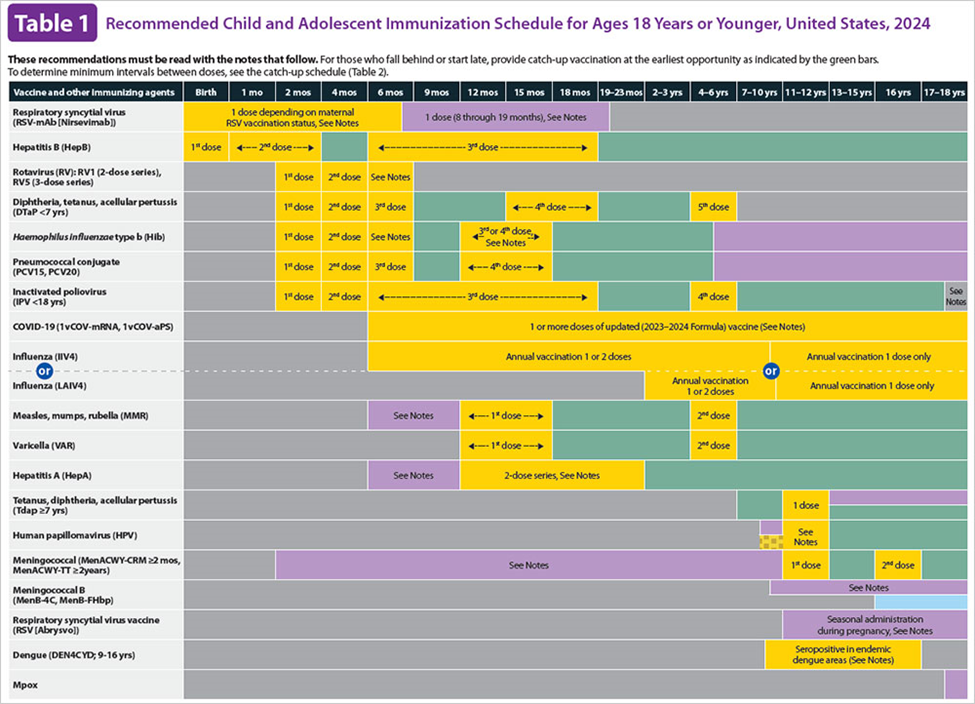A nurse is preparing to administer vaccines to a 4-month-old infant. Which of the following vaccines should the nurse plan to administer?
Influenza
Rotavirus
Measles, mumps, rubella (MMR)
Varicella (VAR)
The Correct Answer is B
A. Influenza:
The influenza vaccine is typically administered annually starting at 6 months of age. It helps protect against seasonal influenza viruses and is usually recommended during the fall or winter months.
B. Rotavirus:
The rotavirus vaccine is routinely administered to infants starting at 2 months of age, with additional doses given at 4 and 6 months of age. It helps prevent rotavirus infection, which can cause severe diarrhea and vomiting in infants and young children.
C. Measles, mumps, rubella (MMR):
The MMR vaccine is typically administered around 12-15 months of age, with a second dose given at 4-6 years of age. It helps protect against measles, mumps, and rubella, which are contagious viral infections that can cause serious complications.
D. Varicella (VAR):
The varicella vaccine, also known as the chickenpox vaccine, is usually administered around 12-15 months of age, with a second dose given at 4-6 years of age. It helps prevent chickenpox, a highly contagious viral infection characterized by a rash and fever.

Nursing Test Bank
Naxlex Comprehensive Predictor Exams
Related Questions
Correct Answer is C
Explanation
A. "There are a few causes of this condition and they tell me my child has crossed eyes because of a muscle imbalance.": This statement demonstrates the mother's comprehension of the cause of strabismus, which can indeed result from a muscle imbalance affecting the alignment of the eyes. Understanding the cause is essential for the mother to grasp the rationale behind treatment interventions.
B. "I will have my child wear an eye patch over the good eye to help strengthen the weak eye.": Patching the stronger eye is a common treatment approach for strabismus to encourage the weaker eye to become stronger and improve alignment. The mother's statement indicates her awareness of this treatment modality.
C. "My child will outgrow this by the time he is 2 years old and be able to see just fine.": While some cases of strabismus may improve as a child grows, not all cases resolve spontaneously. This statement suggests the mother's belief in the possibility of spontaneous resolution, which may be accurate in some instances but not guaranteed for all cases of strabismus.
D. "If this eye patch does not work I know we will have to do surgery to correct my child's crossed eyes.": Surgery is indeed an option for correcting strabismus, especially if conservative measures like patching do not yield satisfactory results. The mother's understanding of this potential treatment escalation reflects her grasp of the condition's management plan.
Correct Answer is C
Explanation
A. Maintain seizure precautions:
While seizures can occur as a complication of bacterial meningitis, maintaining seizure precautions is not the nurse's priority at this stage. Prompt administration of antibiotics to address the underlying infection takes precedence over seizure precautions.
B. Document intake and output:
Documenting intake and output is an important nursing responsibility, but it is not the priority when a child is suspected of having bacterial meningitis. The immediate priority is to initiate antibiotic therapy to treat the infection and prevent further complications.
C. Administer antibiotics when available:
Administering antibiotics is the priority in the care of a child with suspected bacterial meningitis. Antibiotics are crucial for treating the infection and preventing its progression to reduce the risk of serious complications such as brain damage or death.
D. Reduce environmental stimuli:
While reducing environmental stimuli can help manage symptoms and discomfort in a child with bacterial meningitis, it is not the priority at this time. Initiating antibiotic therapy is essential to address the underlying infection, which takes precedence over environmental stimuli reduction.
Whether you are a student looking to ace your exams or a practicing nurse seeking to enhance your expertise , our nursing education contents will empower you with the confidence and competence to make a difference in the lives of patients and become a respected leader in the healthcare field.
Visit Naxlex, invest in your future and unlock endless possibilities with our unparalleled nursing education contents today
Report Wrong Answer on the Current Question
Do you disagree with the answer? If yes, what is your expected answer? Explain.
Kindly be descriptive with the issue you are facing.
